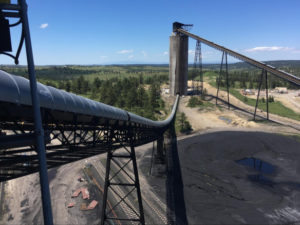 While biking up the hill in Eastern Montana, I thought about my arrival to the United States three years ago. Now I am studying energy issues and climate change while I bike from Billings, MT to Glacier National Park with nine of my classmates. The Wild Rockies Field Institute offers a course called Cycle the Rockies, which seems to be one of the most challenging hills in my college life.
While biking up the hill in Eastern Montana, I thought about my arrival to the United States three years ago. Now I am studying energy issues and climate change while I bike from Billings, MT to Glacier National Park with nine of my classmates. The Wild Rockies Field Institute offers a course called Cycle the Rockies, which seems to be one of the most challenging hills in my college life.
I can see my classmates far away. I only can hear my heavy breath and a sound of the wind. I pedaled harder to catch up with them, but my legs are almost out of energy. Yesterday, we stayed at the beautiful ranch near Billings, Montana. Three dogs came up to us to say hi every morning. The beautiful sunset was the one of the most memorable moments in this trip. I wish I could camp there a little longer. Ranchers in the area are afraid of the ground collapsing due to underground coal mining. This type of mining is risky for ranchers who have natural resources below their land. Additionally, ranchers are concerned about how the coal extraction process will impact their aquifer. These problems can cause issues for human and cattle, and secondary disasters such as accidents on the collapsed land. I have enough time to contemplate many things while I’m biking, so I ask myself, “What is the best solution?” Shifting to renewable energy sounds like a strong candidate. But is the solution that simple?
If you bike in a group, a person who can bike faster leads the rest of group members. The person in the front becomes a windbreak for the next person, and the next person helps the next person to break wind and so on. So you can pedal easily if you are close to someone. But once you fall behind the group, you get the wind on whole your body resulting in more and more distance from your group. Now, I can barely see my classmates. It is a windy day. I need energy to keep pedaling to the top of this hill. I need to eat a cho-coal-ate at next stop but unfortunately I don’t have any. It seems like my classmates are waiting for me on the top of the hill. After this steep hill, there is our destination, Signal Peak Coal Mine, the only underground coal mine in Montana.
A tour inside of the facilities of Signal Peak Energy required us to wear very heavy steel-toed boots. Ninety-eight percent of Signal Peak’s coal products go to Asia, especially, to China, South Korea, Vietnam, and Japan, where I was born and raised. These countries are rapidly climbing up the hill of development. Signal Peak Coal Mine and other energy resources are windbreakers for these countries. The reason why some Asian countries cannot climb up the hill alone is because of their low self-sufficiency ratio of energy supply. Japanese self-sufficiency ratio of energy supply was only 8.3 percent in 2016. This is a really low number compared to Norway which has 702.6 percent of self-sufficient energy. Japan has some nuclear power plants in its own country, however, the nuclear power generation decreased from 11.2 percent to 0.8 percent between 2010 and 2016. This decline of generation happened because of the accident at the nuclear power plant in Fukushima after the earthquake in 2011. Dependency on imports of coal, oil, and natural gas increased more and more in Japan. Seven years since the earthquake happened sounds like a long time has passed for me, but the energy issue doesn’t seem to be developing quickly.
I can’t stop thinking about the ranchers around Signal Peak Coal Mine after I learned that only two percent of Signal Peak’s coal is used in the United States. Do those ranchers suffer for 98 percent exporting coal? For Asian countries? For my friends and family? This happens not only in Montana, but also many other states and countries which provide energy resources to the world.
So what is the best solution? I couldn’t come up with anything while I was biking from Signal Peak coal mine to our next destination. It is a complex international issue. To make a change in coal industries, coal demands also need to be changed. I believe that increasing the renewable energy generation and decreasing the non-renewable energy generation in Asian countries will change the United States’ coal mining production eventually. To make it happen, we need development of new technology of more efficient renewable energy generation and energy storage.